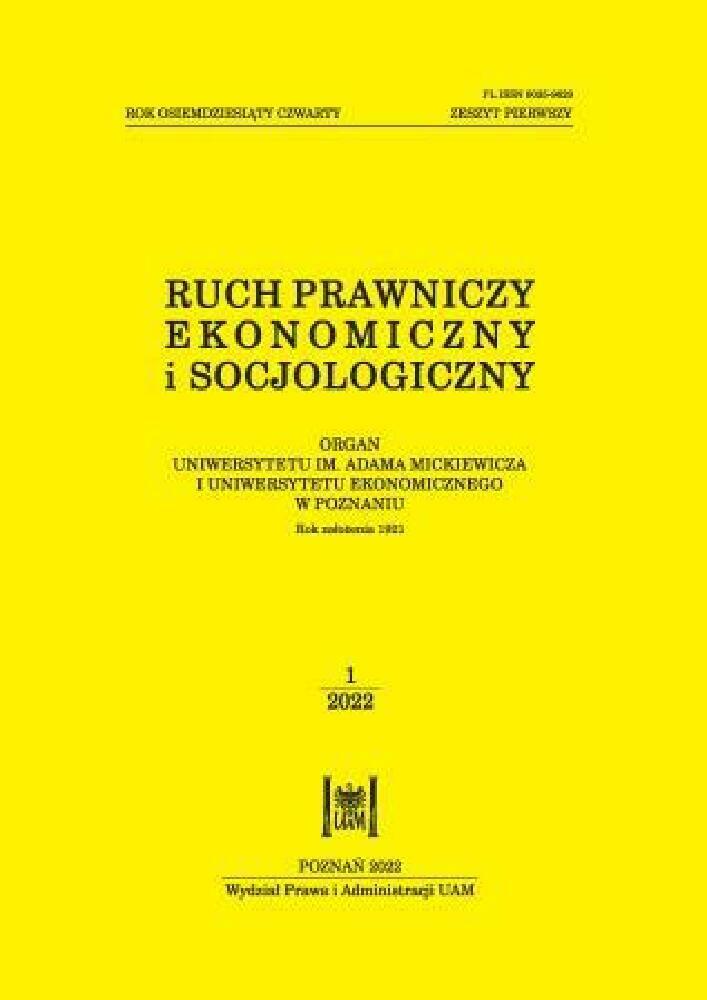Abstract
People working in the legal professions are particularly vulnerable to work-related stress. So far, studies conducted mainly in the United States show that lawyers are experiencing mental health problems, and this applies to every third person working in such professions. However, there are still no analyses of the health and well-being of Polish lawyers. This article presents a part of the results of a nationwide survey on the well-being of representatives of this professional group, which aimed to fill this gap. The main research problem concerned the determination of the level of stress experienced by Polish lawyers. Our goal was also to determine how much time lawyers spend engaged in their work (what is the quantitative workload) and how it relates to their perceived stress at work. It was also important to analyse the stress experienced by lawyers in the context of the stage of professional career development, the legal profession, and the field of law practiced by them. The results of the research (N = 1,779) indicate that the level of stress perceived at work by Polish lawyers is high, regardless of the legal profession they work in or in what field of law they practice, both at the beginning of their careers and by experienced professionals. The heavy workload, which constitutes a serious risk factor for the deterioration of their health, is also a source of concern.
References
Bakker, A.B., Demerouti, E. (2007). The job demands-resources model: state of the art. Journal of Managerial Psychology 22(3): 309–328.
Benjamin, G.A.H., Darling, E.J., Sales, B. (1990). The prevalence of depression, alcohol abuse and cocaine abuse among United States lawyers. International Journal of Law and Psychiatry 13: 233–246.
Chirkowska-Smolak, T. (2008). Równowaga między pracą a życiem osobistym. Ruch Prawniczy, Ekonomiczny i Socjologiczny 70(1): 235–249.
Chirkowska-Smolak, T., Grobelny, J. (2016). Konstrukcja i wstępna analiza psychometryczna Kwestionariusza Postrzeganego Stresu w Pracy (PSwP). Czasopismo Psychologiczne 1(22): 131–139.
Daicoff, S. (2004). Lawyer, Know Thyself: A Psychological Analysis of Personality Strengths and Weaknesses. Washington DC: American Psychological Association. Dimitrova-Grajzl, V., Grajzl, P., Zajc, K., Šušteršič, J. (2012). Judicial Incentives and Performance at Lower Courts: Evidence from Slovenian Judge-Level Data. Review of Law & Economics 8(1): 215–252.
El Bialy, N., Garcia-Rubio, M. (2011). Assessing judicial efficiency of Egyptian first instance courts: a DEA analysis. Joint Discussion Paper. Series in Economics Analysis 19: 1–28.
Elwork, A., Siwik, M.R., Marlowe, D.B. (2007). Stress Management for Lawyers: How to Increase Personal & Professional Satisfaction in the Law. 3rd ed. Vorkell Group.
Gillander, E. (2019). Bearing witness to crime: an examination of secondary traumatic stress and vicarious trauma among attorneys [ProQuest Information & Learning], [w:] Dissertation Abstracts International: Section B: The Sciences and Engineering 80(2–B(E).
Hasnain, N., Naz, I., Bano, S. (2010). Stress and well-being of lawyers. Journal of the Indian Academy of Applied Psychology 36(1): 165–168.
Joński, K., Mańkowski, D. (2014). Is sky the limit? Revisiting ‘exogenous productivity of judges’ argument. International Journal for Court Administration 6(2): 53–72.
Junior Law Division, Resilience and Wellbeing Survey Report 2019, <https://communities.lawsociety. org.uk/Uploads/b/y/k/resilience-wellbeing-survey-report-2019.pdf> [dostęp: 13.03.2022].
Koltai, J., Schieman, S., Dinovitzer, R. (2018). The status-health paradox: organizational context, stress exposure, and well-being in the legal profession. Journal of Health and Social Behavior 59(1): 20–37. doi:10.1177/0022146517754091
Leonard, M.-J., Vasiliadis, H.-M., Leclerc, M.-È., Brunet, A. (2021, November 29). Traumatic stress in Canadian lawyers: a longitudinal study. Psychological Trauma: Theory, Research, Practice, and Policy. Advance online publication. doi:10.1037/tra0001177
Leonie, K. (2020). Junior lawyers and mental ill health, [w:] A. Davies (ed.), Lawyer Health and Wellbeing: How the Legal Profession is Tackling Stress and Creating Resiliency: 77–87. Gosport, Hampshire: ARK Group.
Nelk, N.J., Luscombe, G.M., Medlow, S.D., Hickie, I.B. (2009). Courting the Blues: Attitudes Towards Depression in Australia Law Students and Legal Practitioners. Sydney: Brain & Mind Research Institute.
Patton, P. (2000). Beyond the Bidding Wars: A Survey of Associate Attrition, Departure Destinations & Workplace Incentives: A Year 2000 National Research Study on Lawyer Careers. Washington, D.C.: NALP Foundation for Research & Education.
Rosales-Lopez, V. (2008). Economics of court performance: an empirical analysis. European Journal of Law and Economics 25(3): 231–251.
Schaufeli, W.B., Bakker, A.B. (2004). Job demands, job resources, and their relationship with burnout and engagement: a multi-sample study. Journal of Organizational Behaviour 25: 293–315.
Seligman, M.E.P., Verkuil, P.R., Kang, T.H. (2005). Why lawyers are unhappy. Deakin Law Review 10(1): 49–66.
Smolak, M., Sadurski, W., Chirkowska-Smolak, T. (2020). Rozum publiczny – uzasadnianie sądowe – umysł sędziego. Poznań: Wydawnictwo Naukowe UAM. doi:10.14746/amup.9788323238461
License
Copyright (c) 2022 WPiA UAM

This work is licensed under a Creative Commons Attribution-NonCommercial-NoDerivatives 4.0 International License.





